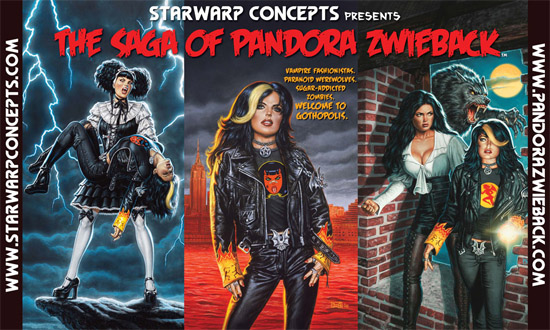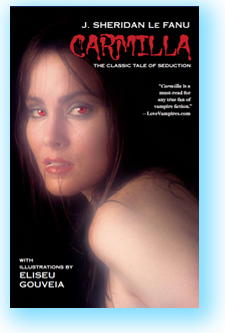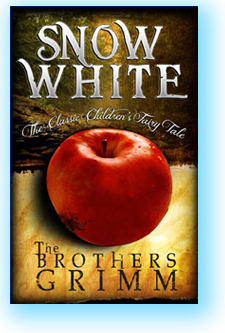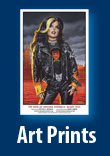The following is the second installment of a four-part interview with StarWarp Concepts owner/publisher/main writer Steven A. Roman (that’s me!) that first appeared on the site Write a Revolution, back in 2015, but since WaR is apparently no longer around, I’m presenting it (with some updates) as part of our 30th Anniversary celebration for all those folks who might not have seen it.
In yesterday’s Part 1, I talked about the inspiration behind our succubus comic character, Lorelei; the horror-comic anthology Lorelei Presents: House Macabre; and what possibly distinguishes StarWarp Concepts from other publishers.
Today, we get into the genesis of our teenaged Goth monster fighter, Pandora Zwieback, and the planning that goes into creating an SWC project. Enjoy!

WaR: In the young adult novels Blood Feud and Blood Reign, you introduce Pandora Zwieback. Who is Pandora and what’s her story?
SR: Pan is a sixteen-year-old Goth who spent the last decade being diagnosed as a paranoid schizophrenic because she can see monsters. But after she meets an immortal monster hunter named Sebastienne “Annie” Mazarin, she learns that she doesn’t suffer from a mental illness—she has the power to see through the human disguises worn by the monsters that actually exist in the world. How she wound up with that power is a complete mystery to her and her parents, but before they ever get a chance to start figuring it out, they get swept up in a war involving vampire clans looking for what they think is an ultimate weapon. And it just so happens that it was delivered to the horror-themed museum owned by Pan’s dad.
Blood Feud: The Saga of Pandora Zwieback, Book 1 introduces Pan and her cast of characters, and sets up the vampire war. Blood Reign: The Saga of Pandora Zwieback, Book 2 continues the story, adding more details on Pan and the relationship Annie had with the fallen angel who’s leading the vampires against humanity. They’re both extremely character-driven novels, because I love writing for Pan and getting her take on this whole potential end-of-the-world scenario she’s found herself in.
WaR: How do you get into the minds of your characters and make them tick? What I mean is, when you’re writing about women for example or characters that experience things that you have no personal knowledge of, how do you keep it realistic?
SR: That’s a good question—I’m stilltrying to figure out how I’ve managed to get inside Pan’s head! I mean, obviously, I’ve got no experience in being a sixteen-year-old girl, but I do remember being something of a socially awkward nerd in high school, so I have that to draw on, to some degree. I’ve taken the old axiom about writers writing what they know and applied that to her, so she’s a horror fan and Mets baseball fan and comic book lover, and then I add more facets to her character as I go along.
So far, it’s been working—my favorite convention story involves me telling a woman about Blood Feud and explaining Pan’s character in some detail, and her response was, “That sounds fascinating. Is the woman who wrote the book here?” When I pointed out that I was the author, she said, “That’s incredible! But how could you know what it’s like to be a sixteen-year-old girl?”
I think a lot of getting into the mental processes of the characters comes by playing certain kinds of music to set a mood. If I want to write a sad scene—say, like the discussion between Pan and her mom in Blood Feud, about the effect her parents’ divorce has had on her—I’ll play something that’ll intentionally make me feel melancholy, and put it on a loop. If I get a little misty-eyed when I read the scene over, then I know I’ve gotten inside Pan’s head and nailed down her emotions. For action scenes, I usually play movie sound tracks.
WaR: What level or research and planning goes into each project you undertake at StarWarp?
SR: I’m not really the kind who does market research to see if there’s an audience for what we publish, because more often than not our titles tend to be counter to whatever is considered hot or trendy at any given time. When the first Pan novel, Blood Feud, came out, Twilight was still popular—but there’s nothing romantic or “sparkly” about the vampires I write; in fact, some reviewers went out of their way to point out that Blood Feud is a polar opposite to Meyer’s books, in terms of depth of characterization and the violent nature of the vampires—and how much they preferred my approach.
The Lorelei projects are completely at odds with today’s comic market, given the sexual nature of the character and her appearance—the blown-out hair, the unbuttoned blouse, and the stiletto-heel boots. But then again, I’m not going after people who only read mainstream or alt-press comics. Like I said before, Lori is a throwback to old horror comics—if you’re not into those, then Lorelei probably won’t appeal to you. And yet the Sects and the City graphic novel is our most popular title with horror fans.
The Illustrated Classics line we have—which right now consists of the vampire novella Carmilla, Edgar Rice Burroughs’ A Princess of Mars, the 1932 novelization of the original King Kong, and the Brothers Grimm’s Snow White—are chosen for various reasons: they’re well-written books I enjoy; there’s some movie or event I can tie them to; or I know they’ll appeal to dark fantasy fans.
Carmilla involves vampires, so that was a no-brainer—vampires will never go out of style. A Princess of Mars was published to take advantage of Disney’s John Carter movie, since the movie’s based on that novel, and it’s a book I’ve enjoyed since I first read it as a teenager. King Kong was the first monster movie I ever saw as a kid, when it used to run on TV, and the novelization includes material that isn’t in the final version of the film. And Snow White came about because I found a children’s storybook published in the late 1800s, with pristine, full-color illustrations; since the book was in the public domain, we scanned the art and released it as an e-book. And the original spot illustrations for Carmilla and Princess—all done by Eliseu Gouveia—and Paul Tuma’s illustrations for King Kong are a major selling point for those books.
That’s the end of part 2. Drop by tomorrow for Part 3!









